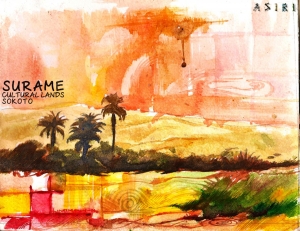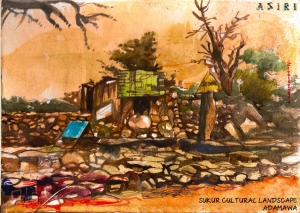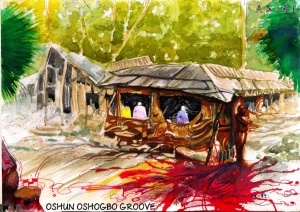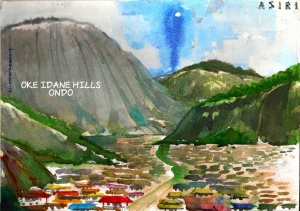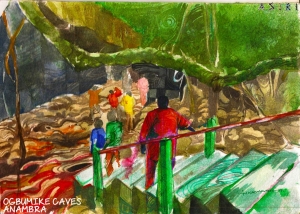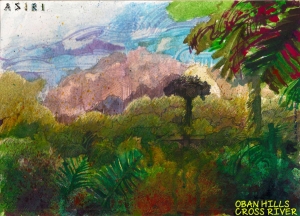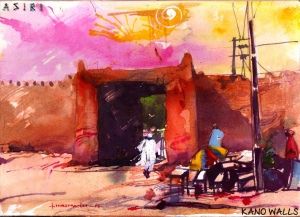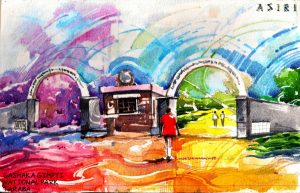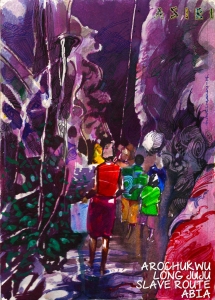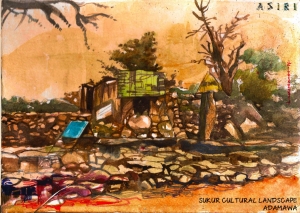
Asiri prides itself as being a preserver of Nigeria’s cultural heritage, history values and lifestyle.
The founder, Damola Ogundele, explained that the essence of the new project “is to use art as a medium to make Nigeria and its Tourism agencies all around the country appreciate the essence of our cultural and historical landmarks and also use this as pointers that these landmarks can be preserved and used as a major source of income for the country via the Tourism Industry and also encourage the use of art as a medium of change and a tool for positive enlightenment”.
Some of these historical landmarks include:
1) Sukur cultural landscape Adamawa; located on top of the plains on the Mandara Mountains in a place called Madagali, Adamawa state. The Sukur Cultural Landscape is Nigeria’s first landmark to be inscribed on UNESCO World Heritage Site in 1999.
2) Oshun-Oshogbo Groove; Located a few miles from ile-ife, the cradle of Yoruba civilisation, the Oshun Oshogbo groove is the mysterious and scared groove for the Oshun goddess one of the wives of the 4th Alaafin of Oyo, Sango, who defied death and became a god. The groove speaks of the essence of Yoruba culture with its different works of art in carvings and sculptures. The groove was listed as a UNESCO World Heritage site in 2005.
3) Oban hills, Cross River; Established in 1988 as a part of the Cross River National park , the Oban hills is a natural habitat for wildlife and plants of unknown species. Breath taking beauty, the Oban hills speaks of the great unspeakable beauty of Nigeria’s forestry.
4) Kano Walls Built in the 14th Century, the Great Walls of Kano is a clear testimony of undefined Sophistication and rare specialisation of the Nigerian people in ancient times, built to protect and control trade in the ancient city of Kano. The 14km radius earth monument stands apart like the Great Walls of China as they were built in the same century. The Walls was listed as a UNESCO World Heritage site in 2007.
5) Oke idanre hills Ondo; Mysterious in look, the real natives of the Hills over the years speak of the mysterious and powerful powers that lies in the great Idanre Hills in Ondo state, blessed with magnificent stones that is about 3,000 feet above the sea level. It was listed in 2007 on the tentative list of UNESCO World Heritage sites.
6) Ogbumike Caves Anambra; Known as one of the greatest wonder of the East, the Ogbumike Caves according to legend was discovered by a hunter called “Ukwa”. It is associated with spiritual and historical significance and listed in 2007 on the tentative list of the UNESCO World Heritage Sites. The caves can be descended in a 317 steps.
7) Alok Ikom Monoliths Cross Rivers; Over time, the mystery of how the Alok Ikom Monoliths came into existence has been a subject of debate and many mysterious tales by the natives of the area. 300 carved stones that are upright with heights that varies and grouped in circles, each facing one another. The size and markings on the stones has been dated to about centuries ago and still a subject of study by Historians. in 2008, it was added to the tentative list of the UNESCO World Heritage Site.
8) Gashaka-Gimpti National Park Taraba; Situated within the Mountain of Death, Chappal Wadi and Mountain of Wind, Chappal Hendu. The Gashaka-Gimpti National Park is a home to the rarest species of primates and houses giant forest hogs, chimpanzees, leopard, lion, hippopotamus, yellow-backed ducker, hartebeest and buffalo and birds.
9) Arochukwu Long juju Slave route Abia; Said to be the home of the shrine of Ibin Ukpabi with a domineering cult statute of Kamalu-‘The Ancient Warrior god’ still standing. It contains an altar, a water fall and there is a six foot gully that leads people to this cave temple. The mysterious stories and myth surrounding this cave can be told over a long course of a life time and all stories considered true. The cave was listed in 2007 on the tentative list of UNESCO World Heritage Sites. There is a famous feature the Iyi-Eke which was an outlet for slaves to be transported to Calabar.
10) Surame Cultural Lands Sokoto; Surame is an ancient city in Sokoto State, created in the 16th Century by Muhammadu Kanta Sarkin Kebbi and abandoned in the `1700. It is regarded as one of the world’s wonders of the human civilisation, ingenuity and creativity. It’s wall is made of massive stones and has a Palace of the Hidi; the Chief of the village. It was declared as an ancient Nigeria’s National Monument in 1964 and added in the Cultural and Natural category of the UNESCO World Heritage Tentative List in 2007.


